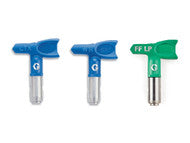What Do The Numbers On An Airless Spray Tip Mean?
The Airless Spray Tip is quite possibly the most important part of an airless spray painting setup. Understanding how they work will ensure choosing the correct one for any given application, saving in labour and material costs.
'You will use twice as much paint' - is one of the most common sayings when it comes to spray painting.
This is not true when you spray with the optimal tip at the optimal pressure. Done correctly spray painting will use only a marginal amount more product.
What The Numbers On The Airless Spray Tip Tell You
All tips will have 3 or 4 numbers imprinted on them. These numbers tell you 2 things. Firstly the size of the fan, and secondly the volume and the viscosity of the product that you can spray.
The first digit* tells you the size of the fan. To make it really simple, it is in inches and is measured at 12 inches from the surface you are spraying. For example, a 211 will give you a 4" (100mm) fan and a 521 will give you a 10" (250mm) fan when spraying at 12" (300mm) distance.
*(Wide tips have 4 digits e.g. 1221, same principle as above applies, the spray pattern will be 24 inch)
Knowing this allows you to determine what width you require. For example, if painting a door frame you would want a narrow spray, but if painting a roof then a larger fan is required.
The last 2 digits are the size of the orifice in thousandths of an inch. The bigger the number, the bigger the hole for the paint to flow through. Using the examples from earlier, a 211 has a 0.011 inch orifice, while the 521 has a 0.021 orifice.
Choosing the optimal orifice size will be determined by 2 things
1/ How much product you need to apply. This will be directly determined by what you are spraying. For example, if painting new plasterboard. This is very porous and will soak up the paint, so a bigger hole is ideal. However, if final coating doors, you want a lighter spray to avoid runs.
2/ What paint am I using. A thin viscosity product like stain will require a small opening, while membranes and high solid products will require a much larger opening.
Understanding The Colours
You may have noticed that the major brands have a range of different coloured tips. These are used to differentiate between the different types of tips. The most common tips are:
Low Pressure Tips - HEA or FFLP
Wagner HEA - High Efficiency Airless (green)
Graco FFLP - Fine Finish Low Pressure (green)
Low Pressure Tips work via a two stage atomization process allowing the product to be sprayed at around 900psi - 1100psi (this is a general indication only). The result is up to half the overspray, softer more even finishes and less wear on your pump. These are fast becoming the first choice of professional contractors due to their low overspray and the superb finish.
General Tips
Wagner - Trade Tip 3 (yellow)
Graco RAC - Reverse A Clean (blue or black)
The most common tip available, with an operating pressure right up to 5000psi, with over 90 sizes available. These will spray everything from stains and lacquers to high builds and mastics.
Line Marking
Wagner - Line Painter (white)
Graco - LineLazer / FieldLazer (yellow)
Where all other tips are designed to have an overlapping spray pattern, these tips are designed for a single purpose, to create razor sharp lines. They should only be used for things like road marking or setting out a sports field.
If you choose the right tip for your application and the product you are using, you will not waste paint!
My personal approach to choosing a tip is as follows:
Small fan / orifice for small surfaces (209, 211, 311, 313), e.g. architraves, windows, furniture.
Medium fan / orifice for medium surfaces (315, 413, 415, 417), e.g. walls, ceilings.
Big fan / orifice for large areas (515, 517, 519, 521), e.g. roofs, large ceilings, new plaster board.
Always check the product you are using, as often the manufacturer will have a recommended tip size!
*Originally Posted by Matt Piggin on 28th March 2019

